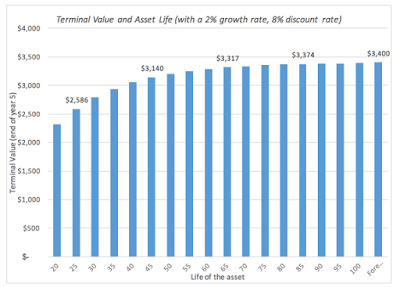To understand the role that a terminal value plays in a discounted cash flow valuation, let us revisit the equation that characterizes a DCF:
The cash flow and discount rate can be defined in equity terms (as cash flows left over after debt payments and cost of equity) or firm terms (pre-debt cash flows and cost of capital). Not only does that the very notion of "forever" scare some from using DCF but it becomes the cudgel used by DCF skeptics to bash the very notion of a discounted cash flow value.
In fact, the presumption of there being only one way to estimate the terminal value is wrong. Within the present value framework, there are two simple devices that exist that allow us to make this judgment without breaking the basis for the model.
1. If it is a finite life asset (say 40 or 50 years), you can use an annuity or growing annuity formula to compute the terminal value. For instance, consider a 40-year asset with the following cash flows:
| Year | 1 | 2 | 3 | 4 | 5 | 6-40 |
|---|---|---|---|---|---|---|
| Cash flow | $100 | $125 | $150 | $175 | $200 | Grows at 2% a year |
Faced with the question of whether to use going concern value or liquidation value, it is common sense that dictates the answer. If you are valuing a privately owned restaurant or retail store, with a favorable lease on a prime location, you may decide to value the business over the remaining life of the lease rather than assume a continuing business, simply because a lease renegotiation could very quickly change the economics of the business. Similarly, when valuing a personal services business with an aging owner, you should recognize that the actuarial tables will conflict with the "forever" assumption.
And One Non-starter: A Trojan Horse DCF
There is a third way that is used to estimate terminal value that undercuts the notion of intrinsic value, which is what DCF is designed to measure. That is the use of a multiple of some operating metric (revenues, earnings etc.) in your terminal year to get to a terminal value. In almost every case where this is done, the multiple that is used to estimate the terminal value comes from looking at what peer group companies trade at, in the market today. Thus, if telecomm companies collectively trade at a EV/EBITDA multiple of six today, that multiple is used on the EBITDA in year n to arrive at a terminal value.
That makes he biggest number in your DCF a pricing, and it is for this reason that I labeled these “Trojan Horse” valuations in my post on dysfunctional DCFs. As have argued in multiple posts, there is nothing wrong with pricing a business and that may be what you are asked to do, but if that is the case, you should do a simple pricing and not go through the charade of estimating cash flows and discount rates, giving the patina of an intrinsic value estimate.
Conclusion
As in my posts on discount rates, I would like to emphasize that the DCF approach is much more flexible than people give it credit for being. Thus, if your pet peeve with DCFs is the assumption that cash flows last forever and keep growing, it is time to let go of that grievance. There are other ways of estimating the terminal value that you should be more comfortable with and that you can substitute for the perpetual growth model. The only cautionary note is that using a multiple obtained by looking at what peer group companies introduces an overwhelming pricing element into your intrinsic valuation.
YouTube Video
DCF Myth Posts
- If you have a D(discount rate) and a CF (cash flow), you have a DCF.
- A DCF is an exercise in modeling & number crunching.
- You cannot do a DCF when there is too much uncertainty.
- It's all about D in the DCF (Myths 4.1, 4.2, 4.3, 4.4 & 4.5)
- The Terminal Value: Elephant in the Room! (Myths 5.1, 5.2, 5.3, 5.4 & 5.5)
- A DCF requires too many assumptions and can be manipulated to yield any value you want.
- A DCF cannot value brand name or other intangibles.
- A DCF yields a conservative estimate of value.
- If your DCF value changes significantly over time, there is something wrong with your valuation.
- A DCF is an academic exercise.























